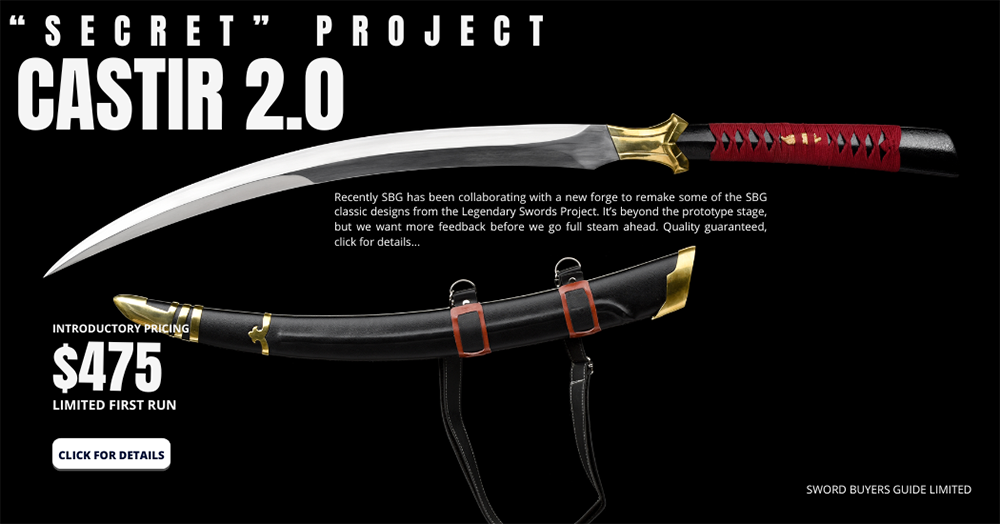|
|
Post by Student of Sword on Jan 10, 2011 5:55:49 GMT
I saw this over at Sinosword: www.sinosword.com/ProductShow/?p ... -zhanmadao . They said that it is a zhanmadao (horse chopping saber). However, if you look closely, it is not a Chinese blade of any type. It is Japanese. It is either Unokubi Zukuri or a very long naginata blade. Maybe I am wrong and there was a Chinese blade with that profile. Anyone with special insight? |
|
|
|
Post by Vincent Dolan on Jan 10, 2011 6:27:05 GMT
It is indeed a Zhanmadao. The dao itself was originally a single edged jian with a sharpened false edge for about 7-8" (look at Tang style dao) and eventually started to curve while keeping that false edge. The main difference is that false edge is sharpened, whereas on the unokubi, it is not.
As for why it resembles a Japanese sword, well, just remember that Japanese swords are innovations from Chinese blades; in this case, the zhanmadao is probably the origin of the nagamaki due to their similarities.
|
|
|
|
Post by Student of Sword on Jan 10, 2011 7:13:51 GMT
Here are a few pictures from wikipedia of zhanmadao. They are not very clear, but it seems that the profile is very different from the one I first posted. What I see lacking in the later pictures are the short bohi, then after the bohi the cross-section of the blade changes radically into a diamond shape, then back to the normal cross section near the tip. This is clearly unique to the unokubi zukuri.
Unokubi Zukuri and its cousin, Kanmuri-Otoshi Zukuri, was first record in the Yamato School in 1182. The Japanese swords evolved from the Tang Dynasty sword. Early Chukoto and Tang Saber is identical. Zhanmadao was developed a Song Era.
Is there a clearer picture of an antique Zhanmadao out there somewhere?
|
|
|
|
Post by Vincent Dolan on Jan 10, 2011 7:50:15 GMT
Unfortunately, there isn't to my knowledge. All I have to go on are references to surviving examples being similar to the nagamaki in construction.
The zhanmadao is mentioned in the Wujing Zongyao (Collection of the Most Important Military Techniques) from 1072 as having been in use as an anti-cavalry weapon since the time of Emperor Chang of the Han Dyansty (33BCE - 7BCE); it is very possible that there was indeed a false edge on them, but, when they became less useful compared to other weapons (such as the guandao or pudao), they could have been cut down into plain old dao, so the only surviving examples do not record fullers or false edges. Of course, this is speculation since there's virtually no information on this weapon outside of the above mentioned manual on the internet.
|
|
|
|
Post by chuckinohio on Jan 10, 2011 14:27:03 GMT
I own one of those very same weapons from Sinosword and the false edge is not sharpened, it is exactly like Student pointed out, very close to a Unokubi Zukuri profile.
As far as the historic aspects of the blade I can not comment, I purchased it solely for its looks and uniqueness.
Student, you may be interested to know that the grip on this weapon is very fat and has absolutely no taper. I know you have voiced your preferences on Tsuka before, and this may be a concern for you if considering it. It is more or less a sledgehammer handle in profile.
|
|
Marc Kaden Ridgeway
Member
Retired Global Moderator
Awful lot of leaving and joining going on here for me .... And gosh I can't recall doing a bit of i
Posts: 8,778
|
Post by Marc Kaden Ridgeway on Jan 10, 2011 15:19:50 GMT
Thomas Chen has some good info on Zhan ma dao...  |
|
Marc Kaden Ridgeway
Member
Retired Global Moderator
Awful lot of leaving and joining going on here for me .... And gosh I can't recall doing a bit of i
Posts: 8,778
|
Post by Marc Kaden Ridgeway on Jan 10, 2011 15:22:17 GMT
As for the kanmuri otoshi profile of the one pictured from sino-sword... it is my opinion that zhan ma dao did not have such a blade shape...
|
|

